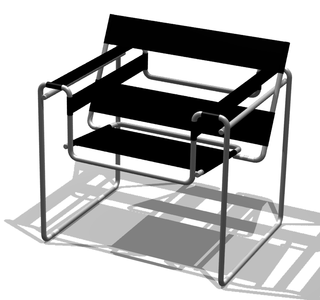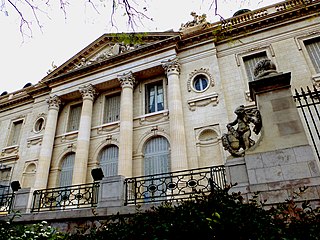Related Research Articles

Gustav Stickley was an American furniture manufacturer, design leader, publisher, and a leading voice in the American Arts and Crafts movement. Stickley's design philosophy was a major influence on American Craftsman architecture.

MillerKnoll, Inc., doing business as Herman Miller, is an American company that produces office furniture, equipment, and home furnishings. Its best known designs include the Aeron chair, Noguchi table, Marshmallow sofa, Mirra chair, and the Eames Lounge Chair. Herman Miller is also credited with the 1968 invention of the office cubicle under then-director of research Robert Propst.

George Katsutoshi Nakashima was an American woodworker, architect, and furniture maker who was one of the leading innovators of 20th century furniture design and a father of the American craft movement. In 1983, he accepted the Order of the Sacred Treasure, an honor bestowed by the Emperor of Japan and the Japanese government.
T. H. Robsjohn-Gibbings (1903–1976) was a British-born architect and furniture designer.

Russel Wright was an American industrial designer. His best-selling ceramic dinnerware was credited with encouraging the general public to enjoy creative modern design at table with his many other ranges of furniture, accessories, and textiles. The Russel and Mary Wright Design Gallery at Manitoga in upstate New York records how the "Wrights shaped modern American lifestyle".

A butterfly joint, also called a bow tie, dovetail key, Dutchman joint, or Nakashima joint, is a type of joint or inlay used to hold two or more pieces of wood together. These types of joints are mainly used for aesthetics, but they can also be used to reinforce cracks in pieces of wood, doors, picture frames, or drawers.

Knoll is an American company that manufactures office systems, seating, storage systems, tables, desks, textiles, and accessories for the home, office, and higher education. The company is the licensed manufacturer of furniture designed by architects and designers such as Harry Bertoia, Ludwig Mies van der Rohe, Florence Knoll, Frank Gehry, Charles Gwathmey, Maya Lin, Marcel Breuer, Eero Saarinen, and Lella and Massimo Vignelli, under the company's KnollStudio division. Over 40 Knoll designs can be found in the permanent design collection of the Museum of Modern Art in New York City.
Ercol is the name of a British furniture manufacturer. The firm dates back to 1920, when it was established in High Wycombe, Buckinghamshire, as Furniture Industries by Lucian Ercolani (1888–1976).

Paul T. Frankl, an Art Deco furniture designer and maker, architect, painter and writer from Vienna, Austria, was the son of a wealthy real estate speculator.

Craftsman Farms is a historic house located in Parsippany-Troy Hills, Morris County, New Jersey, United States. It was founded by noted early 20th century designer Gustav Stickley as a farm and school for the Arts and Crafts movement. It remained in use until 1915 when it was sold to a family and became a private house.

Daniel Pabst was a German-born American cabinetmaker of the Victorian Era. He is credited with some of the most extraordinary custom interiors and hand-crafted furniture in the United States. Sometimes working in collaboration with architect Frank Furness (1839–1912), he made pieces in the Renaissance Revival, Neo-Grec, Modern Gothic, and Colonial Revival styles. Examples of his work are in the collections of the Metropolitan Museum of Art, the Philadelphia Museum of Art, the Art Institute of Chicago, and the Victoria and Albert Museum in London.

Harvey Ellis was an American architect, perspective renderer, painter and furniture designer. He worked in Rochester, New York; Utica, New York; St. Paul, Minnesota; Minneapolis, Minnesota; St. Joseph, Missouri; St. Louis, Missouri and Syracuse, New York.

Mission furniture is a style of furniture that originated in the late 19th century. It traces its origins to a chair made by A.J. Forbes around 1894 for San Francisco's Swedenborgian Church. The term mission furniture was first popularized by Joseph P. McHugh of New York, a furniture manufacturer and retailer who copied these chairs and offered a line of stylistically related furnishings by 1898. The word mission references the Spanish missions throughout colonial California, though the design of most Mission Style furniture owed little to the original furnishings of these missions. The style became increasingly popular following the 1901 Pan-American Exposition in Buffalo. The style was popularly associated with the American Arts and Crafts movement.

The National Museum of Decorative Arts is an art museum in Recoleta, Buenos Aires, Argentina.

Live edge or natural edge is a style of furniture where the furniture designer or craftsperson incorporates the natural edge of the wood into the design of the piece. Live edge furniture often incorporates gnarly wood, such as Alligator Juniper, mesquite, Vachellia nilotica and salvaged wood that could not be used in conventional woodworking. There are special challenges involved in working with this type of wood, and several methods for live edge have developed. Some leave the natural holes and cracks in the wood while other artists fill them with resins.
Charles P. Limbert (1854–1923) was an American furniture designer. He is considered one of the most successful furniture leaders in the history of Grand Rapids and the Arts and Crafts movement in America. The furniture that bears his name is highly sought after and seriously collected to this day. His designs were mainly inspired by such diverse influences as English Arts and Crafts, Dutch folk furniture, Scottish architect/designer Charles Rennie Mackintosh, and the Vienna Secession.

Kimbel & Cabus was a Victorian-era furniture and decorative arts firm based in New York City. The partnership was formed in 1862 between German-born cabinetmaker Anthony Kimbel and French-born cabinetmaker Joseph Cabus (1824–1894). The company was noted for its Modern Gothic and Anglo-Japanese style furniture, which it popularized at the 1876 Centennial Exposition.

Gillows of Lancaster and London, also known as Gillow & Co., was an English furniture making firm based in Lancaster, Lancashire, and in London. It was founded around in Lancaster in about 1730 by Robert Gillow (1704–1772).
The Casa Encantada at 10644 Bellagio Road in Bel Air, Los Angeles is a large detached neoclassical style house completed in 1938. It was designed by James Dolena with interiors and furnishings by T. H. Robsjohn-Gibbings. It has twice established a record for the most expensive house sold in the United States.

The 1911 Grand Rapids furniture workers' strike was a general strike performed by furniture workers in Grand Rapids, which was then a national leader of furniture production.
References
- 1 2 3 Baxter, Albert. "History of the City of Grand Rapids". The Early Days of Widdicomb Furniture. Grand Rapids History. Retrieved October 8, 2012.
- 1 2 3 4 5 Carron, Christian G. "Widdicomb Furniture Company". Grand Rapids Furniture: The Story of America’s Furniture City. Grand Rapids Public Museum. Retrieved October 8, 2012.
- ↑ "Stickley will revive Widdicomb | Furniture Today". www.furnituretoday.com. August 12, 2002. Retrieved January 9, 2017.
- ↑ "Best Bamboo Standing Desks". July 9, 2021.
- ↑ "Widdicomb Furniture Company | People | Collection of Cooper Hewitt, Smithsonian Design Museum". collection.cooperhewitt.org.